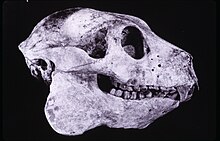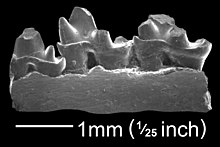Berthe Rakotosamimanana
| ụdịekere | nwanyị |
|---|---|
| mba o sị | Madagascar |
| Aha ọmụmụ | Berthe Rasoamialinivo |
| aha enyere | Berthe |
| ụbọchị ọmụmụ ya | 18 Jenụwarị 1938 |
| Ebe ọmụmụ | Andasibe |
| Ụbọchị ọnwụ ya | 29 Novemba 2005 |
| Ebe ọ nwụrụ | Antananarivo |
| ọrụ ọ na-arụ | zoologist, primatologist, parasitologist |
Mmalite ndụ ya
[dezie | dezie ebe o si]A mụrụ Rakotosamimanana na Andasibe dị na Moramanga District na abalị iri na asatọ nke ọnwa Jenụwarị afọ 1938.[1] Ọ gụrụ akwụkwọ na Mahadum Paris VII, ngalaba Sayensị, inweta nzere na Animal Biology and anthropology.[1] Mgbe ọ laghachiri n'afọ 1967 ọ rụrụ ọrụ na Nkega Geology na Mahadum Madagascar.[1] Ọ lụrụ onye na-ahụ maka ụmụ anụmanụ bụ Philibert Rakotosamimanana.[2]
Ọrụ ya
[dezie | dezie ebe o si]Ọrụ Rakotosamimanana na Ngalaba Geology, site na nke mbụ gụnyere nlekọta na ịkụzi akụkụ ndị a na-eme n'aka nke isiokwu ahụ.[2] Mgbe afọ asaa gasịrị, ya na onye ọrụ ibe ya Ọkàmmụta Henri Rakotoarivelo, guzobere ọrụ paleontology nke mbụ na mahadum ahụ n'afọ 1974.[2]
N'afọ 1977, e nyere ya nzere dọkịnta site na Mahadum Paris VII, nke akpọrọ "La diversité anthropologique des isolats des hautes terres de l'Imerina (Madagascar). Confrontation du biologique et du social".[3] Nnyocha a nyochara ụdị ndị mmadụ dị iche iche na agbụrụ ha dị iche iche na ụdị mmekọrịta ha na Imerina Highlands.[1]
N'afọ 1993, ọrụ paleontology ghọrọ Ngalaba zuru oke, karịsịa n'ihi atụmatụ ya, ọ bụkwa onye isi ya site n'afọ1995 ruo 1998[1] O mepụtara ngalaba atọ ọhụrụ ọzọ: Physical Anthropology, Nutritional Anthropology, Primatology and Evolutionary Biology.[2] Ọ rụsiri ọrụ ike na ngalaba ahụ ruo 2003 mgbe olekọtara ụmụ akwụkwọ ndị chọrọ ịbụ dọkịnta ruokwa mgbe ọ nwụrụ.[1]
N'oge niile ọ na-arụ ọrụ, Rakotosamimanana bụ onye otu ọtụtụ òtù ndị ọkachamara, gụnyere "Groupe d'Etude et de Recherche sur les Primate de Madagascar" (GERP).[2] Òtù ndị ọzọ ọ sonyekwara gụnyere: Malagasy Academy, ndị ọrụ "Ranomafana National Park", IUCN / SSC Primate Survival Commission, ndị òtù nchịkọta akụkọ nke "International Journal of Primatology" na "Lemur News", Society of Human Biometrics, Society of Anthropology of Paris na International Association of Anthropologists.[1]
Mgbe nsogbu ego na Madagascar mere na àgbàtà 1980 na 1989 gasịrị, Rakotosamimanana bụ otu n'ime ndị na-esepụta ụlọ owuwu gara ije ka ụlọ ọrụ ehiwere inyere ndị mmadụ aka nke ndi mba ọzọ kwalite mmemme, nke ga-aba uru n'ezie maka mmepe nke mba ahụ.[4] Dị ka odeakwụkwọ ukwu nke ọgbakọ nke iri na asaa nke International Primatological Society, Rakotosamimanana rụgidere gọọmentị ka ha kwenye inye mahadum mba ahụ nnukwu ego iji kwadebe maka nzukọ 1998, nke emere na Antananarivo.[4] Site n'afọ 1977 ruo afọ 1983 ọ bụ onye isi na ngalaba nnyocha sayensị na Ministrị n'ahụ maka agụmakwụkwọ and Nnyocha sayensị nke Madagascar.[2] Site na 1986 ruo n'afọ 1992 ọ bụ onye ndụmọdụ teknụzụ n'otu Ministri ahụ.[2] Ọ bụ onye rụsiri ọrụ ike n'ịmepụta atụmatụ National Environmental Action Plan nke Madagascar.[5]
Ihe Eji Echeta ya
[dezie | dezie ebe o si]
Nnyocha Rakotosamimanana lekwasịrị anya na fossil na subfossil ụmụ anụmanụ na-enye nwa ara na Madagascar.[6]
Ụdị ihe dị iche iche akpọkwasịrị aha Rakotosamimanana
[dezie | dezie ebe o si]Microcebus berthae
[dezie | dezie ebe o si]N'oge ndụ Rakotosamimanana, a gụrụ ụdị òké lemur a kọwara ọhụrụ aha ya: Madame Berthe's mouse lemur. Ndị dere nkọwa mbụ ahụ kwanyere ùgwù otuto nye nhazi nnyocha ogologo oge nke ha na German Primate Centre mere na Kirindy-Mitea National Park, bụ ebe obibi nke lemur ọhụrụ.[7]
Microcebus berthae bụ anụ ya na mmadụ nọ n'ótù agbụrụ nke kacha nta n'ụwa, nke achọpụtara n'afọ 1992 n'oké ọhịa Menabe.[8]
Coua berthae
[dezie | dezie ebe o si]N'afọ 1993, ndị na-eme nchọpụta kpọrọ ụdị anụmaanụ n'emepụta ihe eji eme akwa (silk) n'adịkwaghị n'ụwa ugbua, a na-akpọbu (Coua berthae maọbụ Madame Berthe's Coua), n'aha Rakotosamimanana.[9][10]
Nkọwa ndị mbụ
[dezie | dezie ebe o si]Rakotosamimanana so n'ime ndị otu mbụ ndị kọwara:
- † Babakotia, ụdị lemur nke nwụchara anwụ n'ihe na-erughị ótù puku afọ gara aga.[11]
- † Ambondro mahabo, anụ na-enye nwa ara mbụ sitere na Madagascar Middle Jurassic.[12]

Okpokoro isi Babakotia radofilai 
Ezé Ambondro lingual, nke a kọwara ma monotypic genus na otu ụdị ya A. mahabo.
Palaeontology
[dezie | dezie ebe o si]Rakotosamimanana jikọrọ aka na mba ụwa ndị ọzọ n'ime ọrụ nyocha paleontology na primatology, ma bụrụkwa onye a na-akwanyere ùgwù na ihe gbasara anụmaanụ ndị há na mmadụ nọ n'ótù agbụrụ ndị si Madagascar, gụnyere òtù esi kesaa ha gafee agwaetiti ahụ. Ọ bụ otu n'ime ndị otu jiri usoro DNA gosipụta na lemur niile ndị si ná Madagascar sitere na ótù nna nna pụta.[13]
Ihe edeputara maka Ọnatarachi fossil nke Madagascar dịbu obere na mbụ, mana Rakotosamimanana so n'otu ndị chọpụtara ebe ọhụrụ ọnatarachi ndị a dị, sitekwa na nkea chọpụta ụfọdụ dinosaurs mbụ nke agwaetiti ahụ.[14] Ndị a gụnyere ụdị abụọ ọhụrụ nke eucynodonts na-abụghị nke na-enye nwa ara.[15]
Primatology
[dezie | dezie ebe o si]Rakotosamimanana nwere mmasị siri ike n'ebe nnyochapụtaSportive Lemur nke Miles Edwards ma mụọ ụzọ ha si eji ebe ihi ụra ha eme ihe, yana igbu ụmụaka n'etiti ha.[16][17] Ọ bụ otu n'ime ndị otu sara mbara nke mere nchọpụta banyere njikọ dị n'etiti ịdị anya nke mkpụrụ ndụ ihe nketa na nkesa n'ala nke lemur ndị dị mkpụmkpụ.[18] Ọrụ ya na ndị ọrụ ibe ya rụrụ na Pachylemur insignis gosipụtara na ọ nwee mmetụta n'ụdị Variecia karịa Lemur.[19] Ọ mụkwara maka ụdi lemur dermatoglyphs.[20]
Ihe odide
[dezie | dezie ebe o si]- ↑ 1.0 1.1 1.2 1.3 1.4 1.5 1.6 RAKOTOSAMIMANANA Berthe (fr-FR). Université d'Antananarivo (2015-06-20). Retrieved on 2020-02-15.
- ↑ 2.0 2.1 2.2 2.3 2.4 2.5 2.6 "Professeur Berthe RAKOTOSAMIMANANA". Lemur News 11.
- ↑ Diversité anthropobiologique des isolats des Hautes-Terres (Imerina, Madagascar) : confrontations du biologique et du social : études comparatives / Berthe Rakotosamimanana née Rasoamialinivo - Sudoc. www.sudoc.fr. Retrieved on 2020-02-16.
- ↑ 4.0 4.1 (2007) "Notes on the History of Ecological Studies of Malagasy Lemurs", Lemurs. Developments in Primatology: Progress and Prospect.. Boston, MA: Springer.
- ↑ Hannah (1998). "Participatory planning, scientific priorities, and landscape conservation in Madagascar" (in en). Environmental Conservation 25 (1): 30–36. DOI:10.1017/S0376892998000071. ISSN 1469-4387.
- ↑ Beolens, Bo. (2009). The eponym dictionary of mammals, Watkins, Michael, 1940-, Grayson, Michael., Baltimore: Johns Hopkins University Press, 41. ISBN 978-0-8018-9533-3. OCLC 593239356.
- ↑ Rasolooarison (2000). "Taxonomic Revision of Mouse Lemurs (Microcebus) in the Western Portions of Madagascar". International Journal of Primatology 21 (6): 963–1019. DOI:10.1023/A:1005511129475.
- ↑ Smallest primate (en-GB). Guinness World Records. Retrieved on 2020-02-16.
- ↑ Brown, Leslie, 1917-1980. (1982). The birds of Africa, Urban, Emil K., Newman, Kenneth, 1924-2006., London: Academic Press, 45. ISBN 0-12-137301-0. OCLC 8982298.
- ↑ Steven M. Goodman and Florent Ravoavy: Identification of bird subfossils from cave surface deposits at Anjohibe, Madagascar, with a description of a new giant Coua (Cuculidae: Couinae) . In: Proceedings of the Biological Society of Washington 1993, Volume 106, No. 1, pp. 24-33, digitized
- ↑ Simons (1992). "A New Giant Subfossil Lemur, Babakotia, and the Evolution of the Sloth Lemurs" (in en). Folia Primatologica 58 (4): 197–203. DOI:10.1159/000156629. ISSN 1421-9980.
- ↑ Flynn (1999). "A Middle Jurassic mammal from Madagascar" (in en). Nature 401 (6748): 57–60. DOI:10.1038/43420. ISSN 1476-4687.
- ↑ Karanth (2005-04-05). "Ancient DNA from giant extinct lemurs confirms single origin of Malagasy primates" (in en). Proceedings of the National Academy of Sciences 102 (14): 5090–5095. DOI:10.1073/pnas.0408354102. ISSN 0027-8424. PMID 15784742.
- ↑ Flynn (1999-10-22). "A Triassic Fauna from Madagascar, Including Early Dinosaurs". Science 286 (5440): 763–765. DOI:10.1126/science.286.5440.763. PMID 10531059.
- ↑ Flynn (2000-09-25). "New Traversodontids (Synapsida: Eucynodontia) from the Triassic of Madagascar". Journal of Vertebrate Paleontology 20 (3): 422–427. DOI:[0422:NTSEFT2.0.CO;2 10.1671/0272-4634(2000)020[0422:NTSEFT]2.0.CO;2]. ISSN 0272-4634.
- ↑ Rasoloharijaona (2003). "Pair-specific usage of sleeping sites and their implications for social organization in a nocturnal Malagasy primate, the Milne Edwards' sportive lemur (Lepilemur edwardsi)" (in en). American Journal of Physical Anthropology 122 (3): 251–258. DOI:10.1002/ajpa.10281. ISSN 1096-8644. PMID 14533183.
- ↑ Rasoloharijaona (2000-02-01). "Infanticide by a Male Milne-Edwards' Sportive Lemur (Lepilemur edwardsi) in Ampijoroa, NW-Madagascar" (in en). International Journal of Primatology 21 (1): 41–45. DOI:10.1023/A:1005419528718. ISSN 1573-8604.
- ↑ Hapke (2005-08-01). "Biogeography of Dwarf Lemurs: Genetic Evidence for Unexpected Patterns in Southeastern Madagascar" (in en). International Journal of Primatology 26 (4): 873–901. DOI:10.1007/s10764-005-5327-0. ISSN 1573-8604.
- ↑ Crovella (1994-10-01). "Molecular biology and systematics of an extinct Lemur:Pachylemur insignis" (in en). Primates 35 (4): 519–522. DOI:10.1007/BF02381961. ISSN 1610-7365.
- ↑ RAKOTOSAMIMANANA (1970). "Etude des dermatoglyphes et des coussinets palmaires et plantaires de quelques Lemuriens Malgaches". Bull. Ass. Anat. 148: 413–510.


